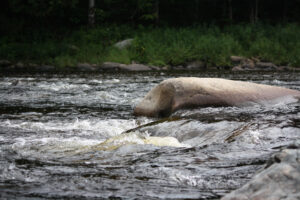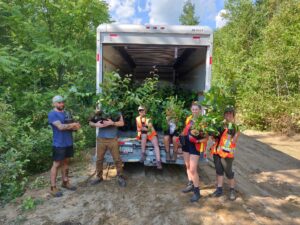 Questions about Water Classification? We’ve prepared this handy fact sheet for you.
Questions about Water Classification? We’ve prepared this handy fact sheet for you.
The Water Classification Regulation:
- is a regulation under the Clean Water Act
- was introduced in 2002
- is used to set goals for water quality and promote management of water on a watershed basis to protect, maintain or improve the water quality of New Brunswick’s lakes and rivers
- establishes water quality classes and standards and outlines the administrative processes and requirements related to the classification of water
Classification of water consists of a 4-step process:
Step 1: Identifying and involving stakeholders and the public
Early in the process, the public is notified in newspapers and other means that the evaluation step has begun. Since evaluation may take a few years, several opportunities are created for the public and stakeholders to become knowledgeable about the classification process and become involved such as public meetings, focus
groups and newspaper advertisements.
Step 2: Evaluating the river system
Evaluation consists of monitoring and sampling over a period of years to determine chemical, physical and biological properties and aquatic life; assessing past, present
and potential uses of land and water; and provide opportunities to develop stakeholder and public consensus on the classification.
Step 3: Establising a vision for the watershed and selecting classes
Once the existing quality of a watercourse is known, the community can work to establish a vision for future water quality and to select a class for the water which would help to acheive the vision. A recommendation is presented to the Minister who undertakes a final public engagement activity to confirm the consensus reached on classification. The Minister then makes the final decision, considering the evaluation and consultation process and informs the public.
Step 4) Implementing classification, including the development of an action plan
In part, water quality goals set through water classification will be achieved through compliance and enforcement activities. Action can be undertaken by watershed groups and stakeholders through activities that protect or improve the quality of the water. Monitoring will help determine if water quality standards are being met and the Department of Environment and Local Government proposes carrying out the monitoring in cooperation with stakeholder groups, with an emphasis on volunteer
monitoring.
Requirements for waters classified under the regulation
Once a watercourse is classified, the water quality standards associated with the class will apply – it will be an offense to use the water or the land within the watershed associated with the watercourse in a way that will, directly or indirectly, cause the quality of the water to cease to meet the class standards or impede or stop any progress in
improvement toward meeting the class standard.
Reclassification can occur only after careful evaluation and public consultation, following a process similar to the procedure that was used to classify the water.
6 Classes for water quality
Outstanding Natural Waters
- AP – Designated Drinking Water Supplies
- AL – Lakes not classified as O or AP
- A – Excellent Water Quality
- B – Good Water Quality
- C – Acceptable Water Quality
Sources
Overview: http://www2.gnb.ca/content/gnb/en/services/services_renderer.201090.html
Planning for Water Quality: http://www.gnb.ca/0009/0371/0003/0001-e.asp
A Guide to New Brunswick’s Water Classification Regulation: http://www.gnb.ca/0009/0371/0003/waterclass-e.pdf
Download a copy of this Fact Sheet on Water Classification [.pdf]
Prepared by the Nashwaak Watershed Association Inc., June 2012

